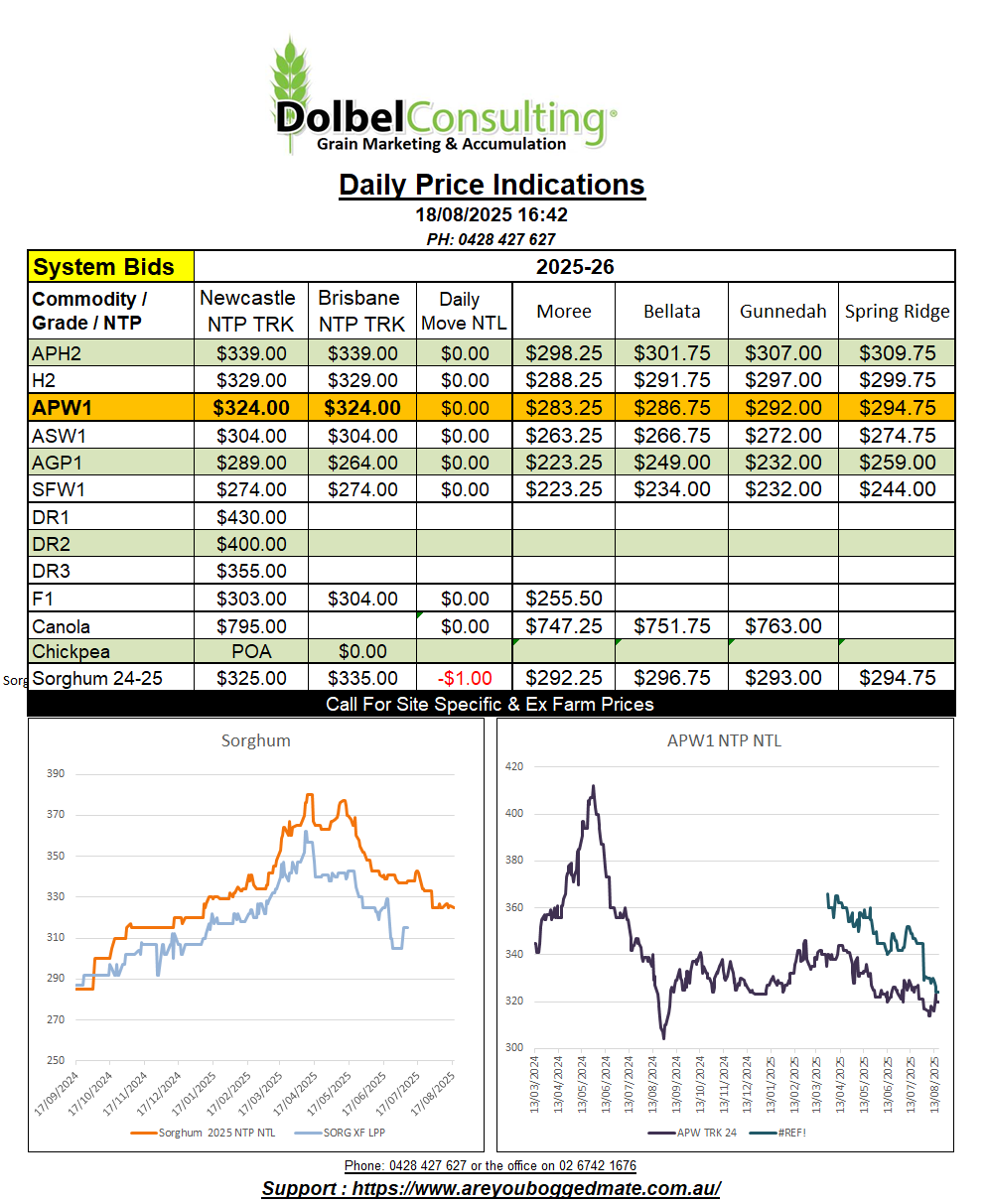18/8/25 Prices

The dollar was a smidge higher this morning, only +0.17%, not enough to take a significant amount away from international cash or futures conversions. Generally grain prices around the world were flat to lower for cash and flat to firmer for futures.
Premium wheat moved lower out of Canada and the USA, cash values on 1CWRS13.5 and US DNS spring wheat out of the Pacific Northwest slipped by AUD$1.89/t and AUD$0.10/t respectfully compared to yesterdays conversions.
Hard red winter wheat out of the PNW bucked the trend in the top grade wheat, clawing back some of this weeks losses. This mornings conversion is up almost AUD$4.00/t compared to yesterday, but still coming in AUD$0.72/t under last Fridays value. One might consider this a win given the 8.75c/bu decline week on week in Chicago HRWW futures. At this mornings money that’s a week on week loss of just under AUD$5.00/t.
Milling wheat out of Argentina fell away. Cash values FOB up river Argie slipped almost AUD$4.00/t yesterday. This isn’t a surprise, Argie values had been much higher than most international seller. The recent drought still fresh in many minds there. The season in Argentina is going great. A quick look at Worldagweather.com shows most of the major wheat producing provinces have seen 110% to 200% of average rainfall over the last 30 days. Parts of Cordoba and Santa Fe receiving 50-100mm of rain from mid July / August. The Pampas region has also seen well above average rainfall with 25-50mm generally, with some locations closer to the east coast picking up 70mm+/-.
Tunisia booked 75kt of wheat at US$262.50 for late September / October. On the back of an envelope Aussie wheat would need to be priced somewhere around AUD$250 – $260 XF LPP to compete with that. Louis Dreyfus the main seller with one boat going to Raya, a new name in the arena. One would assume that at these values it probably Black Sea or EU origin, either would work. Russian wheat production continues to climb with increases in provincial acres pushing winter wheat production higher, spring wheat has also had a dream run and is yet to be harvested.
Much of the analysis I do now days is weighted more towards international cash prices rather than international futures prices. Like futures, cash markets also work on a bid / offer process. This means that on some days prices may be indicated at values that are somewhere between the highest and lowest bid / offer on the international market. This may show up as minor short term spike, that is why it better to take a view on a weighted average from multiple sellers.
There is also the time differences from around the world that can delay cash price publications. Vancouver canola cash value is one that comes to mind for this example. It is often more reliable to convert up country values across Saskatchewan or Alberta to a Vancouver port price than to rely on port cash reporting.
Futures play a roll as they are instant, a good quick reference for price and trend, but these days futures tend to be pushed around by technical trade, including the fund managers and algo traders.
If you are talking to an advisor and they are only using international futures to guide you than they are lacking a part of the larger picture, be a little wary. Those that only report large trades are better, but those that report futures, trades, cash and trends are the ones you need to watch. I’ve always been a big fundamental analyst. Weather being the key, but government intervention will often blind side fundamental analyst, those pesky barstards. Trump and his tariffs, the counter tariffs and cash prices being driven by fundamentals, seem to be the key. One might even say you could get by without the futures market if all these components are monitored effectively. How good would a block chain sales / purchases register be. Not much use for a broker then I guess.
New crop sorghum was bid on the track at $330 NTP Newcastle, just $4.00 better than the old crop. Downs packer was bid at $325.00 delivered M/A.
